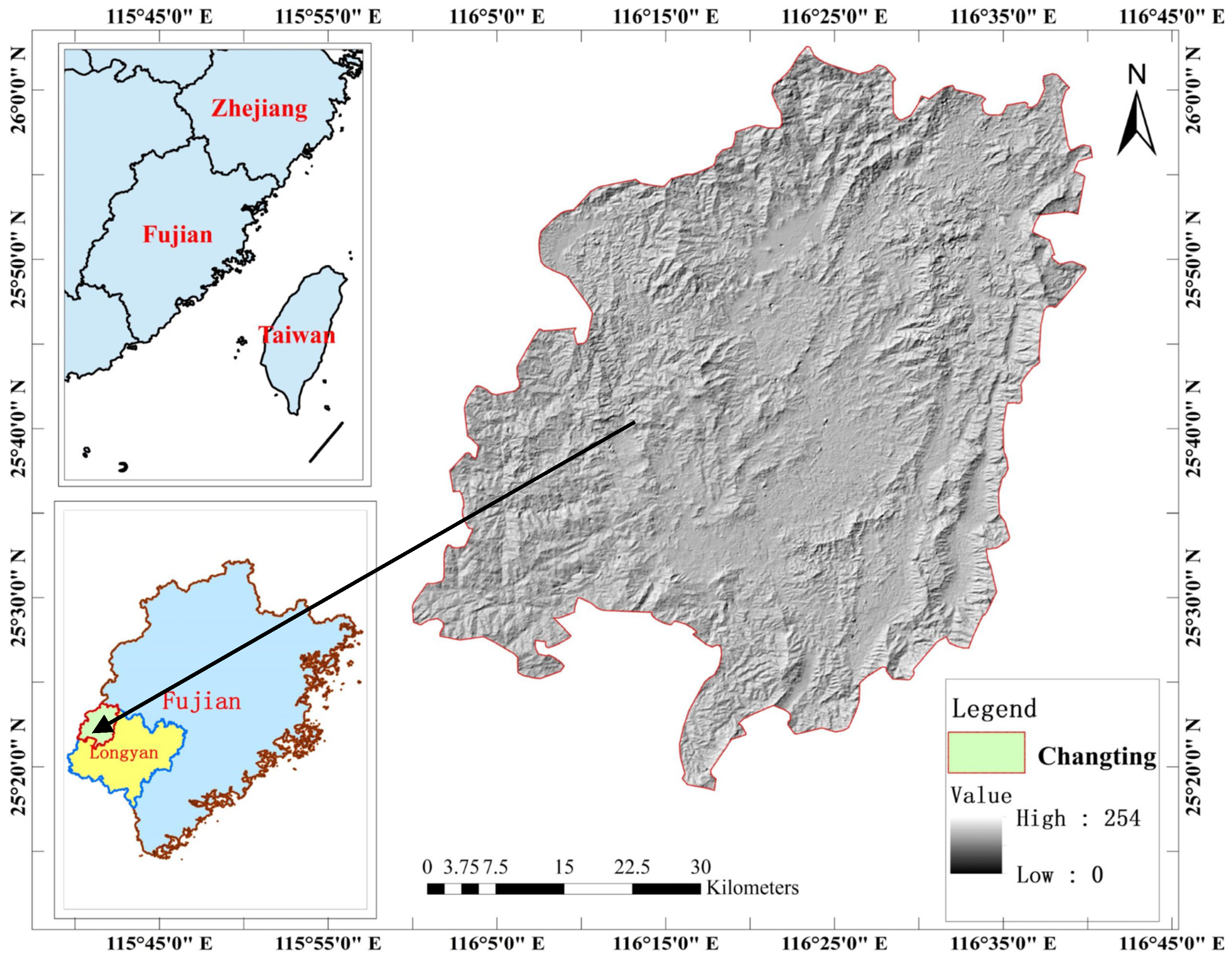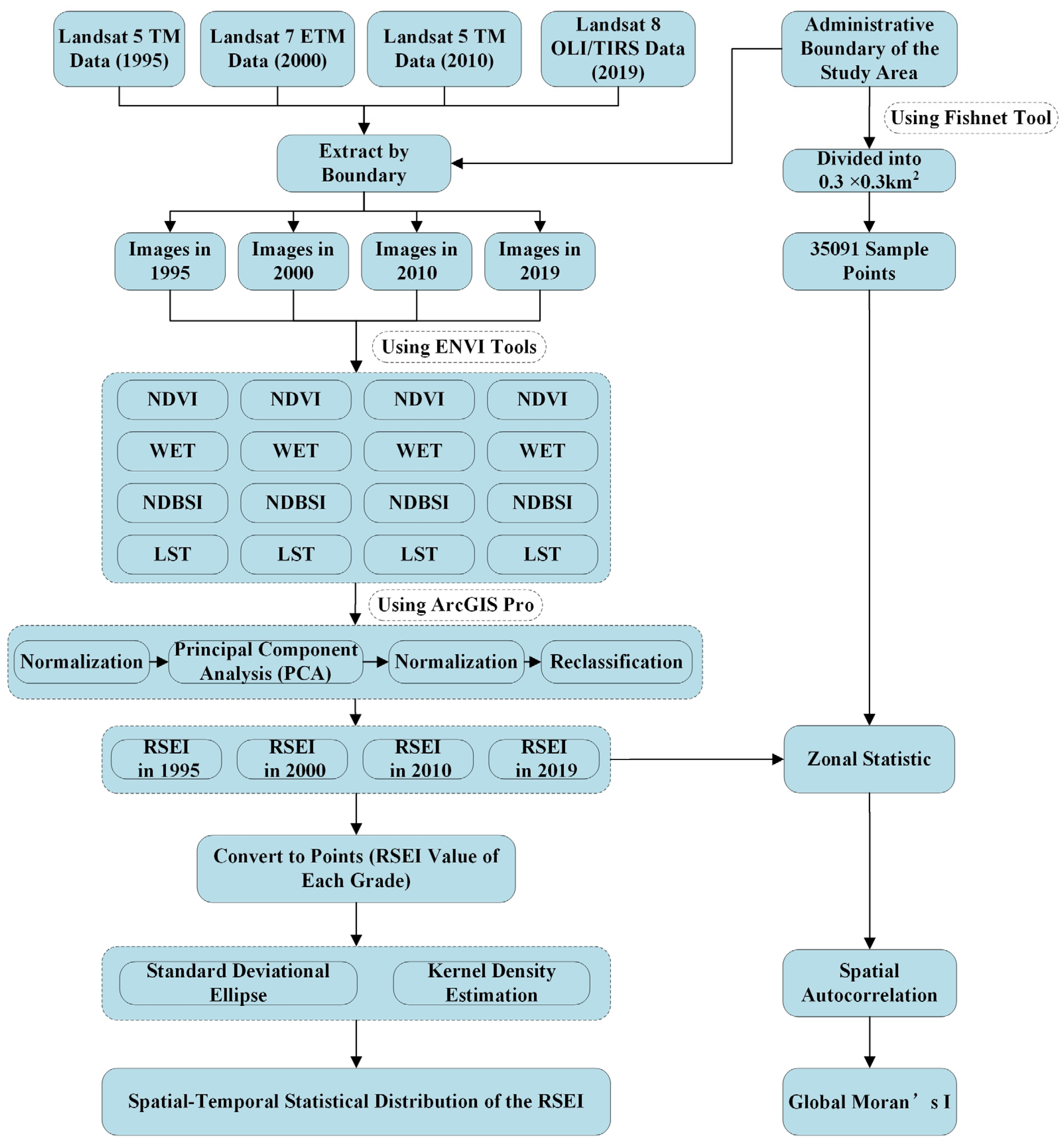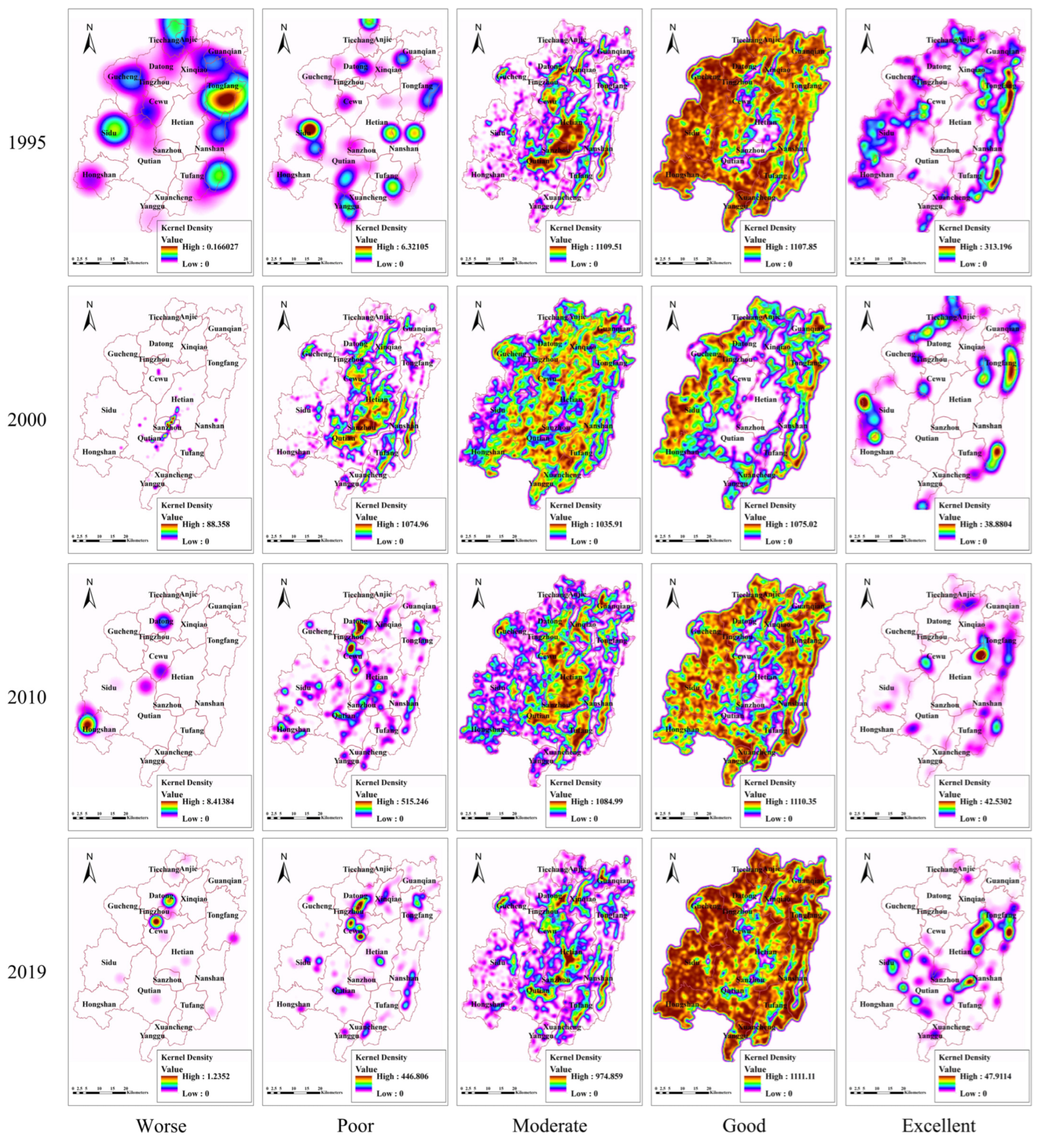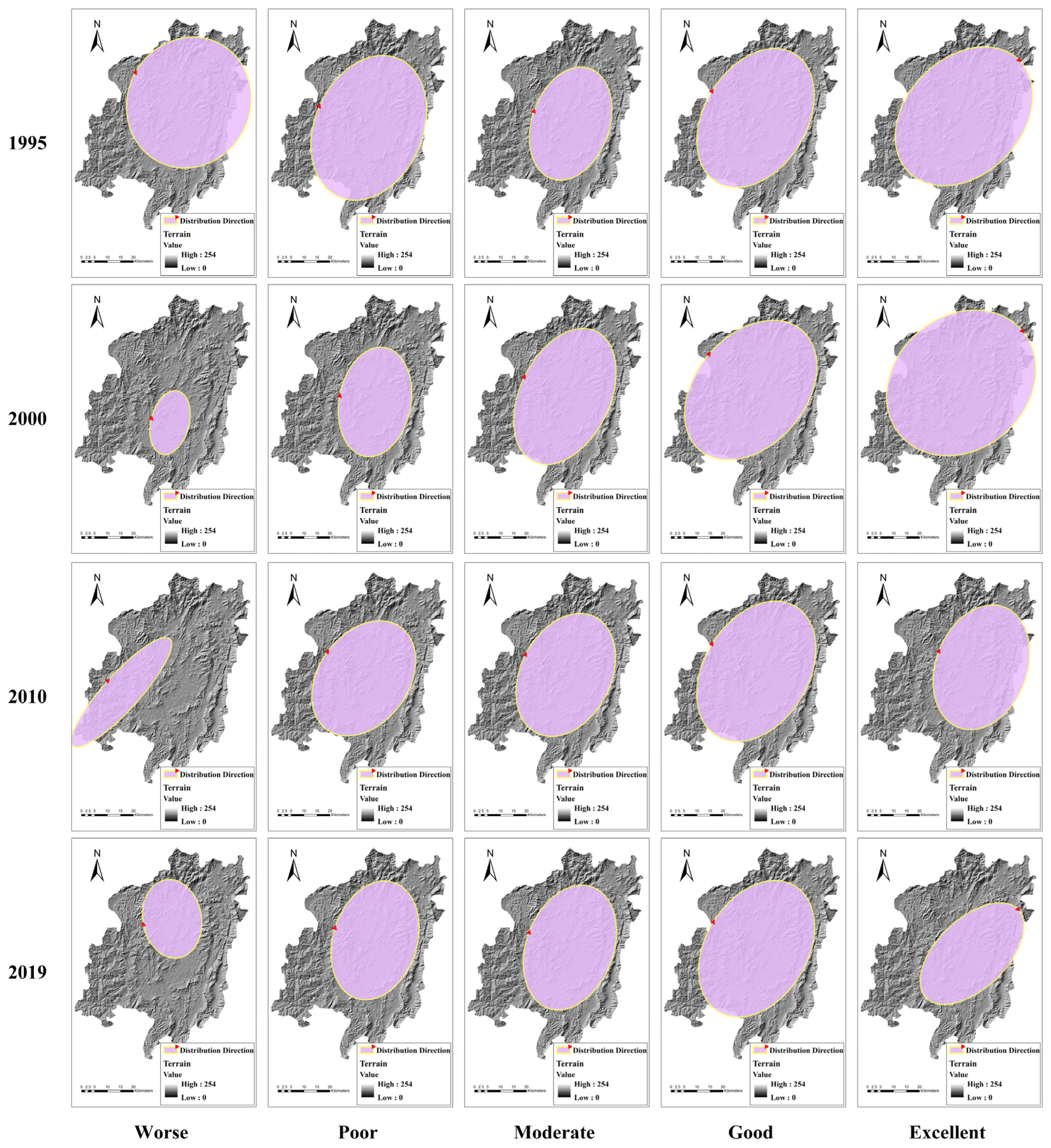Evaluation of Spatial–Temporal Variations in Ecological Environment Quality in the Red Soil Region of Southern China: A Case Study of Changting County
Abstract
:1. Introduction
2. Materials and Methods
2.1. Overview of the Study Area
2.2. Methods
2.2.1. Data Sources and Processing
- (1)
- The vector data of the administrative boundaries of Changting County, Longyan City, and Fujian Province were provided by Fujian Provincial Geographical Information Center located in Fuzhou City, Fujian Province, China.
- (2)
- Landsat images from 1995–2019 were downloaded from the “Geospatial Data Cloud Website “http://www.gscloud.cn/” (accessed on 5 July 2023)” (Table 1) to generate the evaluation indicators.
- (3)
- The study area was divided into a 0.3 × 0.3 km2 grid to generate 35,091 sample points which were used to analyze the spatial autocorrelation characteristics combined with the RSEI.
- (4)
- As shown in Figure 2, the evaluation indicators, the RSEI, and the sample points were generated using ArcGIS Pro 3.2 and ENVI 5.3 software, which were used to further analyze the spatial–temporal distribution characteristics.
2.2.2. Indicators Used in the RSEI
- (1)
- NDVI
- (2)
- WET
- (3)
- NDBSI
- (4)
- LST
2.2.3. Analysis of Spatial Distribution Characteristics
3. Results
3.1. The Variations in EEQ
3.2. The Spatial Aggregation Characteristics of EEQ
3.3. The Directional Distribution Characteristics of EEQ
4. Discussion
4.1. Spatial Correlations between Objects within Eco-Environments
4.2. Comprehensiveness and Complexity of EEQ Evaluation
5. Conclusions
- (1)
- The EEQ of the study area first declined and then recovered from 1995 to 2019. Most areas were of the moderate and good grades, and the overall level of the EEQ was good. NDVI and WET had a positive relation with the EEQ; the contrary was observed for LST and NDBSI.
- (2)
- The spatial distribution of EEQ was clustered rather than random, with a strong positive correlation. The spatial distribution of kernel density of the EEQ for each grade showed an obvious multi-core and multi-level pattern. In particular, the hot spots of kernel density of the moderate-grade areas were located in the towns within the Tingjiang River Basin, and those of the good-grade areas were distributed in the surroundings of the study area during the four periods (1995, 2000, 2010, and 2019).
- (3)
- The distribution of the EEQ areas for each grade was almost in a southwest–northeast direction. Compared with the distributions of other grade areas, the central trend, directional trend, and discrete level of the moderate- and good-grade areas were almost consistent.
Author Contributions
Funding
Institutional Review Board Statement
Informed Consent Statement
Data Availability Statement
Conflicts of Interest
Abbreviations and Acronyms
| EEQ | ecological environment quality |
| RSEI | remote sensing ecological index |
| PCA | principal component analysis |
| PC1 | first principal component |
| NDVI | normalized differential vegetation index |
| NDBSI | normalized differential build-up and soil index |
| IBI | index-based built-up index |
| SI | soil index |
| LST | land surface temperature |
| RE | rare earth |
References
- Liu, P.; Ren, C.; Wang, Z.; Zhang, B.; Chen, L. Assessment of the eco-enviromental quality in the Nanweng River Nature Reserve, Northeast China by remote sensing. Chin. J. Appl. Ecol. 2018, 29, 3347–3356. [Google Scholar] [CrossRef]
- Hu, X.; Xu, H. A New Remote Sensing Index for Assessing the Spatial Heterogeneity in Urban Ecological Quality: A Case from Fuzhou City, China. Ecol. Indic. 2018, 89, 11–21. [Google Scholar] [CrossRef]
- Ma, H.; Shi, L. Assessment of Eco-Environmental Quality of Western Taiwan Straits Economic Zone. Env. Monit. Assess. 2016, 188, 311. [Google Scholar] [CrossRef] [PubMed]
- Xu, H. A remote sensing urban ecological index and its application. Acta Ecol. Sin. 2013, 33, 7853–7862. [Google Scholar] [CrossRef]
- Miao, C.; Sun, L.; Yang, L. The Studies of Ecological Environmental Quality Assessment in Anhui Province Based on Ecological Footprint. Ecol. Indic. 2016, 60, 879–883. [Google Scholar] [CrossRef]
- Nourani, V.; Foroumandi, E.; Sharghi, E.; Dąbrowska, D. Ecological-Environmental Quality Estimation Using Remote Sensing and Combined Artificial Intelligence Techniques. J. Hydroinform. 2021, 23, 47–65. [Google Scholar] [CrossRef]
- Shi, Z.; Li, H. Application of Artificial Neural Network Approach and Remotely Sensed Imagery for Regional Eco-Environmental Quality Evaluation. Env. Monit. Assess. 2007, 128, 217–229. [Google Scholar] [CrossRef]
- Liao, W.; Jiang, W. Evaluation of the Spatiotemporal Variations in the Eco-Environmental Quality in China Based on the Remote Sensing Ecological Index. Remote Sens. 2020, 12, 2462. [Google Scholar] [CrossRef]
- Gong, C.; Lyu, F.; Wang, Y. Spatiotemporal Change and Drivers of Ecosystem Quality in the Loess Plateau Based on RSEI: A Case Study of Shanxi, China. Ecol. Indic. 2023, 155, 111060. [Google Scholar] [CrossRef]
- Gan, X.; Du, X.; Duan, C.; Peng, L. Evaluation of Ecological Environment Quality and Analysis of Influencing Factors in Wuhan City Based on RSEI. Sustainability 2024, 16, 5809. [Google Scholar] [CrossRef]
- Yue, H.; Liu, Y.; Li, Y.; Lu, Y. Eco-Environmental Quality Assessment in China’s 35 Major Cities Based on Remote Sensing Ecological Index. IEEE Access 2019, 7, 51295–51311. [Google Scholar] [CrossRef]
- Ji, J.; Wang, S.; Zhou, Y.; Liu, W.; Wang, L. Studying the Eco-Environmental Quality Variations of Jing-Jin-Ji Urban Agglomeration and Its Driving Factors in Different Ecosystem Service Regions from 2001 to 2015. IEEE Access 2020, 8, 154940–154952. [Google Scholar] [CrossRef]
- Cheng, L.; Wang, Z.; Tian, S.; Liu, Y.; Sun, M.; Yang, Y. Evaluation of eco-environmental quality in Mentougou District of Beijing based on improved remote sensing ecological index. Chin. J. Ecol. 2021, 40, 1177–1185. [Google Scholar] [CrossRef]
- Muhadaisi, A.; Zhang, F.; Liu, K.; Ayinuer, Y. Urban ecological environment evaluation based on Tiangong—2 and Landsat8 data. Remote Sens. Land Resour. 2020, 32, 209–218. [Google Scholar] [CrossRef]
- Wang, S.; Zhang, X.; Zhu, T.; Yang, W.; Zhao, J. Assessment of ecological environment quality in the Changbai Mountain Nature Reserve based on remote sensing technology. Prog. Geogr. 2016, 35, 1269–1278. [Google Scholar] [CrossRef]
- Jing, Y.; Zhang, F.; He, Y.; Kung, H.; Johnson, V.C.; Arikena, M. Assessment of Spatial and Temporal Variation of Ecological Environment Quality in Ebinur Lake Wetland National Nature Reserve, Xinjiang, China. Ecol. Indic. 2020, 110, 105874. [Google Scholar] [CrossRef]
- Zhang, J.; Gu, Y.; Shen, J.; Cong, M.; Sun, Y.; He, J.; Yang, L. Analysis of Spatiotemporal Changes and Driving Factors of Ecological Environment Quality in the Yellow River Basin. Environ. Sci. 2024, 1–23. [Google Scholar] [CrossRef]
- Wang, S.; Wu, W. Spatiotemporal Variation of Ecological Environmental Quality and Its Response to Different Driving Factors in Jialing River Basin in Recent 31 Years. Res. Soil Water Conserv. 2024, 31, 427–439. [Google Scholar] [CrossRef]
- Zhu, D.; Chen, T.; Zhen, N.; Niu, R. Monitoring the Effects of Open-Pit Mining on the Eco-Environment Using a Moving Window-Based Remote Sensing Ecological Index. Env. Sci. Pollut. Res. 2020, 27, 15716–15728. [Google Scholar] [CrossRef]
- Chen, X.; Zeng, X.; Zhao, C.; Qiu, R.; Zhang, L.; Hou, X.; Hu, X. The ecological effect of road network based on remote sensing ecological index: A case study of Fuzhou City, Fujian Province. Acta Ecol. Sin. 2021, 41, 4732–4745. [Google Scholar] [CrossRef]
- Pariha, H.; Zan, M.; Alimjan, K. Remote sensing evaluation of ecological environment in Urumqi City and analysis of driving factors. Arid Zone Res. 2021, 38, 1484–1496. [Google Scholar] [CrossRef]
- Deng, C.; Chen, Z.; Chen, H.; Chen, Z. Hyperspectral Estimation Models of Chlorophyll Content for Dicranopteris Dichotoma Leaves at Different Ecological Restoration Stages in the Eroded Red Soil Areas of Southern China. J. Geo-Inf. Sci. 2019, 21, 948–957. [Google Scholar] [CrossRef]
- Jiang, T.; Xie, Y.; Chen, Z.; Chen, Z.; Chen, J. Reductions of Water Flow and Sediment Under Different Water Conservation Measures in Changting County of Fujian Province. Bull. Soil Water Conserv. 2018, 38, 35–41. [Google Scholar] [CrossRef]
- An, Z.; XI, S. Analysis on the Evolution of Heat Island Effect and Its Influencing Factors in Ningbo Central City from 1990 to 2015. J. Hebei Univ. Eng. (Nat. Sci. Ed.) 2021, 38, 69–77. [Google Scholar]
- Qin, Z.H.; Zhang, M.H.; Karnieli, A.; Berliner, P. Mono-Window Algorithm for Retrieving Land Surface Temperature from Landast TM6 Data. Acta Geogr. Sin. 2001, 56, 456–466. [Google Scholar]
- Gong, J.; Xie, Y.; Zhao, C.; Gao, Y. Landscape ecological risk assessment and its spatiotemporal variation of the Bailongjiang watershed, Gansu. China Environ. Sci. 2014, 34, 2153–2160. [Google Scholar]
- Zhao, L.; Zhao, Z. Projecting the Spatial Variation of Economic Based on the Specific Ellipses in China. Sci. Geogr. Sin. 2014, 34, 979–986. [Google Scholar] [CrossRef]
- Wang, J.; Ma, J.; Xie, F.; Xu, X. Improvement of remote sensing ecological index in arid regions: Taking Ulan Buh Desert as an example. Chin. J. Appl. Ecol. 2020, 31, 3795–3804. [Google Scholar] [CrossRef]
- Guo, Z.; Wei, W.; Zhang, X.; Li, Z.; Zhou, J.; Xie, B. Spatial distribution characteristics and influencing factors of eco-environmental quality based on RS and GIS in Shiyang River Basin, China. Chin. J. Appl. Ecol. 2019, 30, 3075–3086. [Google Scholar] [CrossRef]
- Fu, J.; Cao, G.; Guo, W. Terrain Gradient Change of Land Use and Its Geographical Detector of Terrain Factors on the South-Facing Slope of Qilianshan Mountains from 1980 to 2018. Res. Soil Water Conserv. 2021, 28, 371–382. [Google Scholar] [CrossRef]
- Ren, Y.; Zhou, T.; Li, H.; Xie, S.; Yin, Z. Research on the Urban Ecological Environment Pattern in the Main Urban Area of Chongqing Based on Remote Sensing and POI Data. Prog. Geophys. 2021, 36, 766–778. [Google Scholar] [CrossRef]
- Wang, X.; Gong, W.; Huang, X.; Liu, T.; Zhou, Y.; Li, H. Assessment of Eco-Environmental Quality on Land Use and Land Cover Changes Using Remote Sensing and GIS: A Case Study of Miyun County. Nat. Environ. Pollut. Technol. 2018, 17, 739–746. [Google Scholar]
- Xiong, Q.; Hong, Q.; Chen, W. Temporal and Spatial Response of Ecological Environmental Quality to Land Use Transfer in Nanling Mountain Region, China Based on RSEI: A Case Study of Longnan City. Land 2024, 13, 675. [Google Scholar] [CrossRef]
- Wang, M.; Xu, H. Temporal and spatial changes of urban impervious surface and its influence on urban ecological quality: A comparison between Shanghai and New York. Chin. J. Appl. Ecol. 2018, 29, 3735–3746. [Google Scholar] [CrossRef]
- Shan, W.; Jin, X.; Ren, J.; Wang, Y.; Xu, Z.; Fan, Y.; Gu, Z.; Hong, C.; Lin, J.; Zhou, Y. Ecological Environment Quality Assessment Based on Remote Sensing Data for Land Consolidation. J. Clean. Prod. 2019, 239, 118126. [Google Scholar] [CrossRef]
- Fung, T.; Siu, W. Environmental quality and its changes, an analysis using NDVI. Int. J. Remote Sens. 2000, 21, 1011–1024. [Google Scholar] [CrossRef]
- Baig, M.H.A.; Zhang, L.; Shuai, T.; Tong, Q. Derivation of a tasselled cap transformation based on Landsat 8 at-satellite reflectance. Remote Sens. Lett. 2014, 5, 423–431. [Google Scholar] [CrossRef]
- Crist, E.P. A TM Tasseled Cap equivalent transformation for reflectance factor data—NASA Technical Reports Server (NTRS). Remote Sens. Environ. 1985, 17, 301–306. [Google Scholar] [CrossRef]
- Wu, Y.; Wu, C.F.; Bei, H.L. Geographical distribution characteristics and mechanism of urban office buildings in Hangzhou during the transition period. J. Geogr. 2010, 65, 973–982. [Google Scholar]
- Tobler, W.R. A computer model simulation of urban growth in the Detroit region. Econ. Geogr. 1970, 46 (Suppl. S1), 234–240. [Google Scholar] [CrossRef]
- Chen, J.; Lin, G.; Yang, Z.; Chen, H. Parameters Optimization in Extracting Digital Drainage Networks with DEM. J. Geo-Inf. Sci. 2011, 13, 32–37. [Google Scholar] [CrossRef]





| Year | Acquired Date | Sensor Type | Path/Row | Cloud Cover |
|---|---|---|---|---|
| 1995 | 7 December 1995 | TM5 | 121/42 | 0.00% |
| 2000 | 27 January 2000 | ETM7 | 121/42 | 0.00% |
| 2010 | 14 January 2010 | TM5 | 121/42 | 0.00% |
| 2019 | 23 January 2019 | OLI/TIRS | 121/42 | 2.29% |
| Method Name | Formula | Meaning |
|---|---|---|
| Global Moran’s I | is the spatial weight between elements i and j. | |
| Standard Deviational Ellipse | are the coordinates of the mean center point of all the elements. | |
| Kernel Density Estimation | n is the total number of elements; k is the kernel function; di is the distance between element i and point (x, y); h is the smoothing bandwidth. |
| Year | Indicators | PC1 | PC2 | PC3 | PC4 |
|---|---|---|---|---|---|
| 2019 | NDVI | 0.64257 | 0.42440 | 0.61273 | 0.17764 |
| WET | 0.37449 | 0.04581 | −0.62275 | 0.68549 | |
| LST | −0.43786 | 0.88361 | −0.16250 | 0.03334 | |
| NDBSI | −0.50512 | −0.19257 | 0.45862 | 0.70529 | |
| Eigenvalue | 0.00706 | 0.00223 | 0.00091 | 0.00009 | |
| Percent eigenvalue | 68.6252 | 21.6641 | 8.8444 | 0.8663 | |
| 2010 | NDVI | 0.68931 | 0.42277 | 0.57451 | 0.12671 |
| WET | 0.18434 | −0.04244 | −0.38881 | 0.90169 | |
| LST | −0.46812 | 0.87289 | −0.10121 | 0.09315 | |
| NDBSI | −0.52128 | −0.23985 | 0.71311 | 0.40277 | |
| Eigenvalue | 0.00709 | 0.00221 | 0.00063 | 0.00009 | |
| Percent eigenvalue | 70.7658 | 22.0556 | 6.2941 | 0.8845 | |
| 2000 | NDVI | 0.51739 | 0.74926 | −0.18456 | 0.36993 |
| WET | 0.38822 | −0.39166 | 0.61905 | 0.55917 | |
| LST | −0.62747 | 0.50178 | 0.57647 | 0.14891 | |
| NDBSI | −0.43344 | −0.18284 | −0.50039 | 0.72685 | |
| Eigenvalue | 0.01318 | 0.00217 | 0.00149 | 0.00040 | |
| Percent eigenvalue | 76.4586 | 12.5904 | 8.6319 | 2.3190 | |
| 1995 | NDVI | 0.72551 | −0.13755 | 0.67359 | −0.03147 |
| WET | 0.22259 | 0.00488 | −0.19411 | 0.95538 | |
| LST | −0.32395 | 0.77371 | 0.51515 | 0.17619 | |
| NDBSI | −0.56493 | −0.61184 | 0.49317 | 0.23498 | |
| Eigenvalue | 0.00876 | 0.00152 | 0.00108 | 0.00023 | |
| Percent eigenvalue | 75.5732 | 13.1416 | 9.3369 | 1.9483 |
| Year | Average Value of RSEI | Worse | Poor | Moderate | Good | Excellent | |||||
|---|---|---|---|---|---|---|---|---|---|---|---|
| Area (km2) | Percent (%) | Area (km2) | Percent (%) | Area (km2) | Percent (%) | Area (km2) | Percent (%) | Area (km2) | Percent (%) | ||
| 2019 | 0.672 | 0.04 | 0.001 | 41.92 | 1.35 | 485.87 | 15.66 | 2566.67 | 82.74 | 7.60 | 0.24 |
| 2010 | 0.613 | 0.47 | 0.02 | 73.75 | 2.38 | 1051.45 | 33.89 | 1971.83 | 63.56 | 4.59 | 0.15 |
| 2000 | 0.544 | 1.41 | 0.05 | 477.54 | 15.39 | 1435.49 | 46.28 | 1178.31 | 37.98 | 9.30 | 0.30 |
| 1995 | 0.683 | 0.08 | 0.003 | 1.38 | 0.04 | 639.17 | 20.61 | 2353.82 | 75.89 | 107.04 | 3.45 |
| Grade | Year | Maximum Value of Kernel Density |
|---|---|---|
| Worse | 1995 | 0.166 |
| 2000 | 88.358 | |
| 2010 | 8.414 | |
| 2019 | 1.235 | |
| Poor | 1995 | 6.321 |
| 2000 | 1074.96 | |
| 2010 | 515.246 | |
| 2019 | 446.806 | |
| Moderate | 1995 | 1109.51 |
| 2000 | 1035.91 | |
| 2010 | 1084.99 | |
| 2019 | 974.859 | |
| Good | 1995 | 1107.85 |
| 2000 | 1075.02 | |
| 2010 | 1110.35 | |
| 2019 | 1111.11 | |
| Excellent | 1995 | 313.196 |
| 2000 | 38.88 | |
| 2010 | 42.53 | |
| 2019 | 47.911 |
| Grade | Year | CenterX | CenterY | Orientation | Ratio |
|---|---|---|---|---|---|
| Worse | 1995 | 443,469.590 | 2,848,187.638 | 29.786 | 1.077 |
| 2000 | 436,175.418 | 2,831,295.446 | 14.422 | 1.685 | |
| 2010 | 417,453.093 | 2,834,374.896 | 42.459 | 4.003 | |
| 2019 | 437,002.909 | 2,853,162.378 | 169.679 | 1.337 | |
| Poor | 1995 | 437,054.698 | 2,838,547.998 | 23.922 | 1.385 |
| 2000 | 439,447.415 | 2,839,173.906 | 10.701 | 1.524 | |
| 2010 | 435,112.404 | 2,839,747.363 | 36.753 | 1.398 | |
| 2019 | 439,446.499 | 2,844,932.844 | 17.876 | 1.439 | |
| Moderate | 1995 | 439,107.335 | 2,840,160.009 | 19.398 | 1.490 |
| 2000 | 436,898.412 | 2,841,281.677 | 25.958 | 1.593 | |
| 2010 | 437,221.694 | 2,841,035.908 | 27.237 | 1.428 | |
| 2019 | 435,055.373 | 2,841,756.834 | 32.077 | 1.438 | |
| Good | 1995 | 434,646.179 | 2,842,293.235 | 31.964 | 1.459 |
| 2000 | 432,766.473 | 2,843,662.091 | 41.225 | 1.427 | |
| 2010 | 434,930.276 | 2,842,394.923 | 32.082 | 1.447 | |
| 2019 | 438,836.747 | 2,842,249.420 | 20.849 | 1.466 | |
| Excellent | 1995 | 439,259.369 | 2,842,945.839 | 45.043 | 1.355 |
| 2000 | 438,165.286 | 2,846,443.748 | 50.424 | 1.207 | |
| 2010 | 445,942.400 | 2,843,949.679 | 21.211 | 1.400 | |
| 2019 | 442,370.695 | 2,839,875.941 | 46.776 | 1.834 |
Disclaimer/Publisher’s Note: The statements, opinions and data contained in all publications are solely those of the individual author(s) and contributor(s) and not of MDPI and/or the editor(s). MDPI and/or the editor(s) disclaim responsibility for any injury to people or property resulting from any ideas, methods, instructions or products referred to in the content. |
© 2024 by the authors. Licensee MDPI, Basel, Switzerland. This article is an open access article distributed under the terms and conditions of the Creative Commons Attribution (CC BY) license (https://creativecommons.org/licenses/by/4.0/).
Share and Cite
Chen, J.; Lin, G.; Chen, Z. Evaluation of Spatial–Temporal Variations in Ecological Environment Quality in the Red Soil Region of Southern China: A Case Study of Changting County. Appl. Sci. 2024, 14, 8641. https://doi.org/10.3390/app14198641
Chen J, Lin G, Chen Z. Evaluation of Spatial–Temporal Variations in Ecological Environment Quality in the Red Soil Region of Southern China: A Case Study of Changting County. Applied Sciences. 2024; 14(19):8641. https://doi.org/10.3390/app14198641
Chicago/Turabian StyleChen, Junming, Guangfa Lin, and Zhibiao Chen. 2024. "Evaluation of Spatial–Temporal Variations in Ecological Environment Quality in the Red Soil Region of Southern China: A Case Study of Changting County" Applied Sciences 14, no. 19: 8641. https://doi.org/10.3390/app14198641






